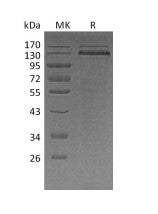1
/
of
2
Recombinant Human THBS1 (C-10His)
Recombinant Human THBS1 (C-10His)
Recombinant Human Thrombospondin-1 is produced by our Mammalian expression system and the target gene encoding Asn19-Pro1170 is expressed with a 10His tag at the C-terminus.
Catalog No:
EPT088
Regular price
$220.00 USD
Regular price
$169.00 USD
Sale price
$220.00 USD
Unit price
/
per
Couldn't load pickup availability
Product Details
Accession
P07996
Molecular Weight
129.2 KDa
Apparent Molecular Weight
130&170 KDa, reducing conditions
Purity
Greater than 85% as determined by reducing SDS-PAGE.
Endotoxin
Less than 0.1 ng/µg (1 EU/µg) as determined by LAL test.
Expression Host
Mammalian
Reconstitution
Always centrifuge tubes before opening.Do not mix by vortex or pipetting.
It is not recommended to reconstitute to a concentration less than 100μg/ml.
Dissolve the lyophilized protein in distilled water.
Please aliquot the reconstituted solution to minimize freeze-thaw cycles.
Shipping Condition
The product is shipped at ambient temperature. Upon receipt, store it immediately at the temperature listed in the Storage field.
Storage Condition and Shelf Life
Lyophilized protein should be stored at < -20C, though stable at room temperature for 3 weeks.
Reconstituted protein solution can be stored at 4-7°C for 2-7 days.
Aliquots of reconstituted samples are stable at < -20C for 3 months.
Background
Thrombospondin-1 (TSP-1) is a 150-180kDa calcium-sensitive protein that is secreted as a disulfide-linked homotrimer. TSP-1 regulates a wide range of cellular functions including their interactions with other cells and with the extracellular matrix (ECM). TSP-1 contains an N-terminal Laminin G-like globular domain, an extended central region with one vWFC domain, 3 TSP type 1domains, 2 EGF-like domains, and 8 TSP type3 domains, and a globular TSP C-terminal domain. Distinct regions of TSP-1 have been associated with binding to particular ECM or cellular molecules. TSP-1 counteracts the angiogenic, hypotensive, and antithrombotic effects of nitric oxide (NO). It binds and neutralizes VEGF, blocks VEGF R2 signaling on vascular endothelial cells(EC), and destabilizes adhesive contacts between EC. TSP-1 also plays an important role in wound repair and tissue fibrosis by binding latent TGF-beta and inducing release of the active cytokine from the latency associated peptide (LAP).
Analyte
THBS1
Regulatory Status
For Research Use Only



